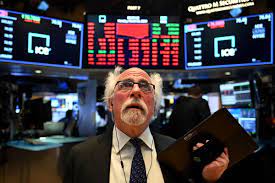The Dow Jones Industrial Average: A Comprehensive Analysis
The Dow Jones Industrial Average, often referred to as the Dow, is one of the most widely recognized stock market indices in the world. It represents the performance of 30 large, publicly traded companies listed on stock exchanges in the United States. Created in 1896 by Charles Dow and Edward Jones, the Dow has become a key indicator of the overall health and direction of the U.S. stock market. In this article, we will delve into the history, composition, calculation, and significance of the Dow Jones Industrial Average.
History
The Dow Jones Industrial Average has a rich history that spans over a century. It was originally designed to provide a snapshot of the U.S. economy and track the performance of major industrial companies. The index started with just 12 companies, including General Electric, American Cotton Oil, and U.S. Leather. Over time, the number of companies included in the index increased to its current count of 30.
Throughout its history, the Dow has witnessed significant milestones and events. It survived the Great Depression of the 1930s, the dot-com bubble of the late 1990s, and the global financial crisis of 2008. The index has evolved to reflect changes in the economy, shifting from an industrial focus to a more diverse representation of various sectors.
Composition
The Dow Jones Industrial Average consists of 30 blue-chip companies that are leaders in their respective industries. These companies are carefully selected by the editors of The Wall Street Journal, which is owned by Dow Jones & Company. The selection process aims to include companies that are representative of different sectors and have a significant impact on the U.S. economy.
The current components of the Dow include well-known names such as Apple, Microsoft, Boeing, Coca-Cola, and Goldman Sachs. The index covers a wide range of sectors, including technology, healthcare, finance, consumer goods, and industrials. The composition of the Dow is periodically reviewed and adjusted to ensure its relevance and accuracy.
Calculation
The Dow Jones Industrial Average is a price-weighted index, which means that the components are weighted based on their stock prices rather than their market capitalization. To calculate the index, the stock prices of the 30 companies are added together and divided by a divisor. This divisor is adjusted periodically to account for stock splits, dividends, and other corporate actions that may affect the index.
The price-weighted nature of the Dow has both advantages and limitations. On one hand, it gives equal importance to each component regardless of its market value. This can be seen as a disadvantage since a higher-priced stock has a greater impact on the index than a lower-priced stock, regardless of the company’s size. However, this methodology has stood the test of time and continues to be used due to its historical significance.
Significance
The Dow Jones Industrial Average holds immense significance in the financial world. It serves as a barometer of investor sentiment and market trends. When the Dow rises, it is often interpreted as a positive sign for the broader stock market and the economy. Conversely, a decline in the Dow can be seen as an indication of market weakness or economic uncertainty.
Many investors and financial professionals use the Dow as a benchmark to evaluate the performance of their portfolios or investment strategies. It provides a quick snapshot of how the largest U.S. companies are performing and can help gauge market sentiment. However, it is important to note that the Dow represents only a small fraction of the thousands of publicly traded companies in the U.S., and therefore, should not be considered as a comprehensive measure of the entire stock market.
Conclusion
The Dow Jones Industrial Average has stood the test of time as a reliable indicator of the U.S. stock market. Its long history, diverse composition, and price-weighted calculation methodology make it a unique and influential index. While it has its limitations, the Dow continues to be closely watched by investors, economists, and financial analysts around the world. Understanding the Dow and its significance can provide valuable insights into market trends and investor sentiment.












